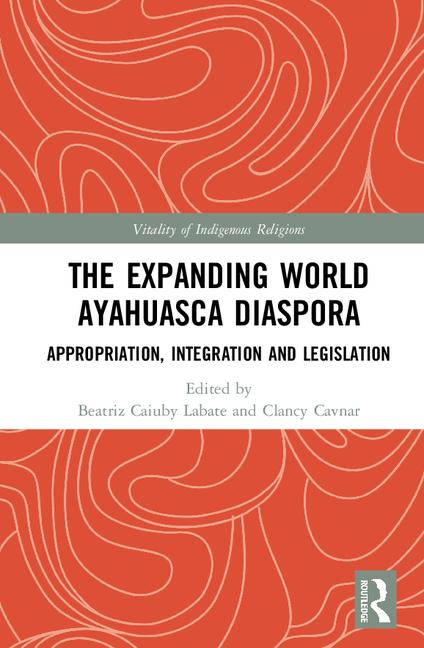- Eight Frequently Asked Questions About Ayahuasca Globalization - February 13, 2024
- Ten Tips for Standing in Solidarity with Indigenous People and Plant Medicines - January 18, 2024
- Genocide by Other Means: Indigenous Peoples and the War on Drugs in Latin America and the Caribbean - December 14, 2023
- Eight Frequently Asked Questions About Ayahuasca Globalization - February 13, 2024
- Ten Tips for Standing in Solidarity with Indigenous People and Plant Medicines - January 18, 2024
- Opening Remarks – Queering Psychedelics II - April 24, 2023
Co-edited by Beatriz Caiuby Labate and Clancy Cavnar
Abstract
This book investigates how certain alternative global religious groups, shamanic tourism industries, and recreational drug milieus grounded in the consumption of the traditionally Amazonian psychoactive drink ayahuasca embody various challenges associated with modern societies. During its expansion from the Amazon jungle to Western societies, ayahuasca use has encountered different legal and cultural responses in the destination countries. This encounter is discussed in the book in terms of how it discloses contemporary controversies regarding religious ambivalence in modern societies, and how disparate and competing ontological and epistemological discourse on ayahuasca use has emerged among ayahuasca drinkers and between them and the state. The role of science in the confrontations between ayahuasca drinkers and the law is also contemplated. The chapters include ethnographic investigations of ritual practice, transnational religious ideology, the politics of healing, and the invention of tradition. Authors explore symbolic effects of a “bureaucratization of enchantment” in religious practice, and the “sanitizing” of indigenous rituals for tourist markets. Larger questions on the global economics of ayahuasca in terms of notions of commodification and the categories of sacred and profane are also addressed. This unique book explores classic and contemporary issues in social science and the humanities, providing rich material on the bourgeoning expansion of ayahuasca use around the globe.
Co-editors’ biographies
Beatriz Caiuby Labate has a Ph.D. in social anthropology from the State University of Campinas (UNICAMP), Brazil. Her main areas of interest are the study of psychoactive substances, drug policy, shamanism, ritual, and religion. She is Adjunct Faculty at the East-West Psychology Program at the California Institute of Integral Studies (CIIS) in San Francisco and Visiting Professor at the Center for Research and Post Graduate Studies in Social Anthropology (CIESAS) in Guadalajara. She is co-founder of the Drugs, Politics, and Culture Collective, in Mexico (http://drogaspoliticacultura.net), and co-founder of the Interdisciplinary Group for Psychoactive Studies (NEIP) in Brazil, as well as editor of NEIP’s website (http://www.neip.info). She is also Chief Editor at Chacruna (https://chacruna.net). She is author, co-author, and co-editor of seventeen books, one special-edition journal, and several peer-reviewed articles (http://bialabate.net).
Clancy Cavnar has a doctorate in clinical psychology (Psy.D.) from John F. Kennedy University in Pleasant Hill, CA. She currently works in private practice in San Francisco, and is an associate editor at Chacruna (https://chacruna.net), a venue for publication of high-quality academic short texts on plant medicines. She is also a research associate of the Interdisciplinary Group for Psychoactive Studies (NEIP). She combines an eclectic array of interests and activities as clinical psychologist, artist, and researcher. She has a master of fine arts in painting from the San Francisco Art Institute, a master’s in counseling from San Francisco State University, and she completed the Certificate in Psychedelic-Assisted Therapy program at the California Institute of Integral Studies. She is author and co-author of articles in several peer-reviewed journals and co-editor, with Beatriz Caiuby Labate, of eight books. For more information see: http://neip.info/pesquisadore/clancy-cavnar
Table of contents
Preface
Foreword
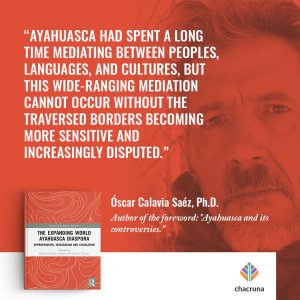
Óscar Calavia Saéz
1- A Critical Review of the Literature on the Diaspora of Brazilian Ayahuasca Religion
Beatriz Caiuby Labate and Glauber Loures de Assis
 Born during the twentieth century, Barquinha, Santo Daime, and the União do Vegetal, known as the Brazilian ayahuasca religions, were circumscribed to the northern region of Brazil at least until the beginning of the 70s. Since then, Santo Daime and the União do Vegetal have expanded significantly, each one in its own way, reaching all the regions of the country, crossing the Brazilian borders and the Atlantic Ocean. The process of internationalization of these groups involves complex nets and transnational alliances, generating intriguing issues on cultural translation and religious diaspora. Nevertheless, the theme is rarely explored and the information is widely scattered. This chapter proposes a critical review of the academic literature on the internationalization of these groups, including articles, master’s theses and doctoral dissertations in various languages, published or not, as well as texts on the legal aspects. Through a comparative approach, we seek to identify the main characteristics,
Born during the twentieth century, Barquinha, Santo Daime, and the União do Vegetal, known as the Brazilian ayahuasca religions, were circumscribed to the northern region of Brazil at least until the beginning of the 70s. Since then, Santo Daime and the União do Vegetal have expanded significantly, each one in its own way, reaching all the regions of the country, crossing the Brazilian borders and the Atlantic Ocean. The process of internationalization of these groups involves complex nets and transnational alliances, generating intriguing issues on cultural translation and religious diaspora. Nevertheless, the theme is rarely explored and the information is widely scattered. This chapter proposes a critical review of the academic literature on the internationalization of these groups, including articles, master’s theses and doctoral dissertations in various languages, published or not, as well as texts on the legal aspects. Through a comparative approach, we seek to identify the main characteristics, tendencies, and perspectives of the ayahuasca field of studies. In this way, we hope to call attention to the possibilities and gaps of this discussion and, at the same time, to stimulate the development of more research. This chapter aims to become a sort of guide to the researchers in this area as well as to be of use to others interested in the subject. The internationalization of the ayahuasca religions has already reached dozens of countries in the world, and offers an interesting locus of study of the interaction among psychedelics, culture, language, and cognition.
tendencies, and perspectives of the ayahuasca field of studies. In this way, we hope to call attention to the possibilities and gaps of this discussion and, at the same time, to stimulate the development of more research. This chapter aims to become a sort of guide to the researchers in this area as well as to be of use to others interested in the subject. The internationalization of the ayahuasca religions has already reached dozens of countries in the world, and offers an interesting locus of study of the interaction among psychedelics, culture, language, and cognition.
2 – Interpellations and Challenges in the Neoshamanic and Ayahuasca Fields in Uruguay
Juan Scuro
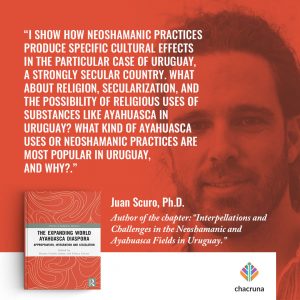 Since the 1990s, three major (neo)shamanic linages associated with sacred plants use have arrived in Uruguay. Each one comes from a particular Latin American national context: Brazil and its ayahuasca religions, Peru and vegetalismo, Mexico and the Red Path. In what way do these practices and discourses develop in a Latin American country imagined as “white,” “without indigenous people,” and “secular,” such as Uruguay? To what extent do the incorporation of these neoshamanic practices question the
Since the 1990s, three major (neo)shamanic linages associated with sacred plants use have arrived in Uruguay. Each one comes from a particular Latin American national context: Brazil and its ayahuasca religions, Peru and vegetalismo, Mexico and the Red Path. In what way do these practices and discourses develop in a Latin American country imagined as “white,” “without indigenous people,” and “secular,” such as Uruguay? To what extent do the incorporation of these neoshamanic practices question the  hegemonic narratives of the state-nation? National stereotypes come into play, with neoshamanisms being both product and producers of these processes of reaffirmation and the breaking down of stereotypes. In this chapter, I briefly describe the arrival of these practices to Uruguay, their specificities and adaptation, and the different relations they established, particularly regarding the use of indigenous spiritualties and sacred plants as therapeutically alternatives. I also analyze the legal and social status of ayahuasca (associated with ritual and spiritual uses) in Uruguay where the medicinal, industrial, and recreational use of cannabis has recently been legalized. Which similarities and differences, dialogues and tensions, exist between use of these two psychoactive substances in the Uruguayan cont
hegemonic narratives of the state-nation? National stereotypes come into play, with neoshamanisms being both product and producers of these processes of reaffirmation and the breaking down of stereotypes. In this chapter, I briefly describe the arrival of these practices to Uruguay, their specificities and adaptation, and the different relations they established, particularly regarding the use of indigenous spiritualties and sacred plants as therapeutically alternatives. I also analyze the legal and social status of ayahuasca (associated with ritual and spiritual uses) in Uruguay where the medicinal, industrial, and recreational use of cannabis has recently been legalized. Which similarities and differences, dialogues and tensions, exist between use of these two psychoactive substances in the Uruguayan cont
3 – “Altered by the Hand of Man”: Contextualizing Ayahuasca Law in Britain and Europe
Jonathan Hobbs
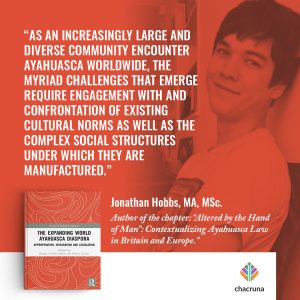 Ayahuasca has a rich and complex cultural heritage but, today, the use of unfamiliar indigenous plant preparations across the continent presents novel challenges. Although it is not subject to international control, recently the number of arrests and prosecutions related to ayahuasca has rapidly increased and the current legal situation is complex and fraught with uncertainty. This chapter aims to trace the background constellation of laws, legal cases, appeals, and debates that, together, can sketch an outline explaining how ayahuasca has arrived at the legal position it currently occupies and what the future could potentially hold. This chapter involves a close study of both reported and unreported proceedings in the courts
Ayahuasca has a rich and complex cultural heritage but, today, the use of unfamiliar indigenous plant preparations across the continent presents novel challenges. Although it is not subject to international control, recently the number of arrests and prosecutions related to ayahuasca has rapidly increased and the current legal situation is complex and fraught with uncertainty. This chapter aims to trace the background constellation of laws, legal cases, appeals, and debates that, together, can sketch an outline explaining how ayahuasca has arrived at the legal position it currently occupies and what the future could potentially hold. This chapter involves a close study of both reported and unreported proceedings in the courts regarding ayahuasca and other plant psychedelics. It includes discussion of a variety of legal texts as well as valuable information gleaned from personal communication with defendants, lawyers and other actors. By examining these sources, it is possible to clarify why the legality of ayahuasca is so difficult to pinpoint as well as the reflexive implications of this complexity on determining the outcome of future cases. Despite binding judgments from the appellate courts, evolving prosecution strategies and recent legislation mean that the pervading uncertainty is no closer to a meaningful resolution. A thorough consideration of the legal and social history from across Europe aims to provide a useful summary of the challenges to both ayahuasca users and jurisprudence scholars.
regarding ayahuasca and other plant psychedelics. It includes discussion of a variety of legal texts as well as valuable information gleaned from personal communication with defendants, lawyers and other actors. By examining these sources, it is possible to clarify why the legality of ayahuasca is so difficult to pinpoint as well as the reflexive implications of this complexity on determining the outcome of future cases. Despite binding judgments from the appellate courts, evolving prosecution strategies and recent legislation mean that the pervading uncertainty is no closer to a meaningful resolution. A thorough consideration of the legal and social history from across Europe aims to provide a useful summary of the challenges to both ayahuasca users and jurisprudence scholars.
4- Santo Daime in a “Post-Catholic” Ireland: Reflecting and Moving on
Guillan Watt
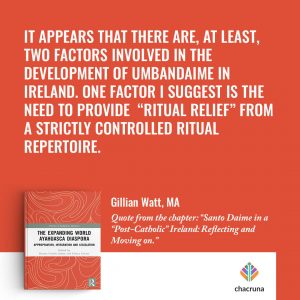 In this chapter I aim to update information about Santo daime in the Republic of Ireland (henceforth referred to as Ireland). I describe the history of the migration of Santo Daime to Ireland and the arrest of a Santo Daime Commander for the possession of DMT which resulted in a pending constitutional case regarding Religious Freedom. This case was pending for several years, during which time significant changes emerged in the Irish religious field, especially as regards the reputation and standing of the institutional Irish Catholic Church, as well as social changes that moved towards a more repressive attitude to psychoactive substances. My contention here is that these two trends influenced the
In this chapter I aim to update information about Santo daime in the Republic of Ireland (henceforth referred to as Ireland). I describe the history of the migration of Santo Daime to Ireland and the arrest of a Santo Daime Commander for the possession of DMT which resulted in a pending constitutional case regarding Religious Freedom. This case was pending for several years, during which time significant changes emerged in the Irish religious field, especially as regards the reputation and standing of the institutional Irish Catholic Church, as well as social changes that moved towards a more repressive attitude to psychoactive substances. My contention here is that these two trends influenced the  outcome of the Constitutional Case. I also suggest through elucidating the changes in Santo Daime ritual since 2013 that these social and religious trends have likewise influenced Santo Daime in Ireland. I suggest that there is as a result a ‘relaxing’ of Catholic habitus (following Inglis’ 2004 use of Bourdieu’s concept ) but that religious identities of the followers of Santo Daime do not altogether detach from Catholicism but rather the religion becomes (following Ganiels 2016) ‘extra-institutional’. In a similar vein with the introduction of more expressive Umbandaime-type Works, current Santo Daime ritual practice also becomes ‘extra-institutional’ to ‘traditional’ and strict forms of Santo Daime. I also point out that an important influence on Santo Daime practice in Ireland is the difficulty in obtaining Daime on account of increased regulatory controls across national borders.
outcome of the Constitutional Case. I also suggest through elucidating the changes in Santo Daime ritual since 2013 that these social and religious trends have likewise influenced Santo Daime in Ireland. I suggest that there is as a result a ‘relaxing’ of Catholic habitus (following Inglis’ 2004 use of Bourdieu’s concept ) but that religious identities of the followers of Santo Daime do not altogether detach from Catholicism but rather the religion becomes (following Ganiels 2016) ‘extra-institutional’. In a similar vein with the introduction of more expressive Umbandaime-type Works, current Santo Daime ritual practice also becomes ‘extra-institutional’ to ‘traditional’ and strict forms of Santo Daime. I also point out that an important influence on Santo Daime practice in Ireland is the difficulty in obtaining Daime on account of increased regulatory controls across national borders.
5 – From Village to Forest: Artistic-Spiritual Partnerships between Ernesto Neto and the Huni Kuin
Ilana Seltzer Goldstein & Beatriz Caiuby Labate
 Recently, installations of the Brazilian artist Ernesto Neto, with different degrees of Indian participation, have been presented in art museums in Bilbao, São Paulo, and Vienna. The beautiful tissue installations achieved part of their force from their references to ayahuasca healing by the Huni Kuin (Kaxinawa) people of the State of Acre in Brazil. It is interesting to note the convergence between the arrival of Indians to the ayahuasca urban circuit and the acquisition of space for Indian works in the arts system. Up until 2000 in Brazil, the consumption of the beverage was promoted mainly by Christian religions. From then on, Indian groups themselves began to organize experiences with ayahuasca attended by middle-class urban people. They also promoted visits to Indian villages in the Amazon. The insertion of Indian
Recently, installations of the Brazilian artist Ernesto Neto, with different degrees of Indian participation, have been presented in art museums in Bilbao, São Paulo, and Vienna. The beautiful tissue installations achieved part of their force from their references to ayahuasca healing by the Huni Kuin (Kaxinawa) people of the State of Acre in Brazil. It is interesting to note the convergence between the arrival of Indians to the ayahuasca urban circuit and the acquisition of space for Indian works in the arts system. Up until 2000 in Brazil, the consumption of the beverage was promoted mainly by Christian religions. From then on, Indian groups themselves began to organize experiences with ayahuasca attended by middle-class urban people. They also promoted visits to Indian villages in the Amazon. The insertion of Indian  artists into contemporary art spaces started only a few years ago in Brazil, although it had already been happening in Australia, Canada, and in the United States since the 90s. The circulation of new forms of shamanism, of ayahuasca consumption, and of artistic objects and performances in national and international urban networks shows the great vigor and adaptability of Indian cultural practices. They represent rich, new possibilities for intercultural dialogue; at the same time, both moves raise delicate issues. First, the consumption of ayahuasca in Brazil is limited only to certain situations; abroad, frequently, it is forbidden. Second, in the case of artistic installations/performances, one can anticipate arguments about how collective intellectual property will be regarded and what are the risks of stereotyping alterity. Our chapter will examine the works by Neto in collaboration with the Huni Kuin in order to offer preliminary reflections on these questions and others about authenticity, cultural appropriation, and commoditization.
artists into contemporary art spaces started only a few years ago in Brazil, although it had already been happening in Australia, Canada, and in the United States since the 90s. The circulation of new forms of shamanism, of ayahuasca consumption, and of artistic objects and performances in national and international urban networks shows the great vigor and adaptability of Indian cultural practices. They represent rich, new possibilities for intercultural dialogue; at the same time, both moves raise delicate issues. First, the consumption of ayahuasca in Brazil is limited only to certain situations; abroad, frequently, it is forbidden. Second, in the case of artistic installations/performances, one can anticipate arguments about how collective intellectual property will be regarded and what are the risks of stereotyping alterity. Our chapter will examine the works by Neto in collaboration with the Huni Kuin in order to offer preliminary reflections on these questions and others about authenticity, cultural appropriation, and commoditization.
6- The Global Expansion of Ayahuasca through the Internet
Matthew Conrad
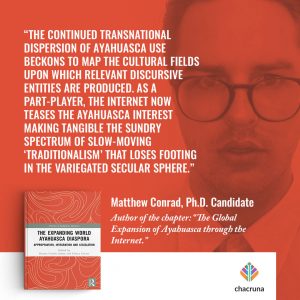 This chapter provides a comprehensive overview of ayahuasca’s presence on the Internet. It assesses a variety of online spaces through which information and cultural products are promoted and disseminated, in order to assess the Internet’s role in the current global expansion of ayahuasca. It is argued that the Internet has been instrumental to ayahuasca’s globalization due its capacity to facilitate the sharing of information and the dissemination of commodities, as well as the development of social networks across vastly disparate geographical locations and cultural groups. Website formats which enable collective
This chapter provides a comprehensive overview of ayahuasca’s presence on the Internet. It assesses a variety of online spaces through which information and cultural products are promoted and disseminated, in order to assess the Internet’s role in the current global expansion of ayahuasca. It is argued that the Internet has been instrumental to ayahuasca’s globalization due its capacity to facilitate the sharing of information and the dissemination of commodities, as well as the development of social networks across vastly disparate geographical locations and cultural groups. Website formats which enable collective 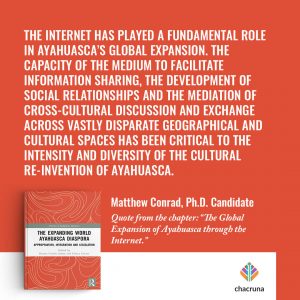 discussion and encourage the relatively liberated negotiation of ideas and opinions have significantly influenced the way in which Peruvian vegetalismo has been re-invented, especially within Western individualistic and consumer contexts. Furthermore, the sharing of information pertaining to ayahuasca analogues used within psychonautic contexts, as well as the promotion and sale of ayahuasca-related commodities on the Internet, such as healing retreats, artworks, books, and the plants themselves, have also greatly expanded the worldwide interest in and accessibility of the entheogen and its related practices. Issues of cultural appropriation, representation, and ownership emerge as important features of ayahuasca’s globalization on the Internet, with novel concepts and practices eventually feeding back into local contexts through offline practice in the tourism setting. The democratized nature of (mis)information sharing on the Internet also poses potential health concerns, and constitutes a significant policy issue for governments and other organizations that seek to influence public perception of the entheogen.
discussion and encourage the relatively liberated negotiation of ideas and opinions have significantly influenced the way in which Peruvian vegetalismo has been re-invented, especially within Western individualistic and consumer contexts. Furthermore, the sharing of information pertaining to ayahuasca analogues used within psychonautic contexts, as well as the promotion and sale of ayahuasca-related commodities on the Internet, such as healing retreats, artworks, books, and the plants themselves, have also greatly expanded the worldwide interest in and accessibility of the entheogen and its related practices. Issues of cultural appropriation, representation, and ownership emerge as important features of ayahuasca’s globalization on the Internet, with novel concepts and practices eventually feeding back into local contexts through offline practice in the tourism setting. The democratized nature of (mis)information sharing on the Internet also poses potential health concerns, and constitutes a significant policy issue for governments and other organizations that seek to influence public perception of the entheogen.
7- Ayahuasca’s Influence on Gay Identity
Clancy Cavnar
 Ayahuasca has been found in some research to have positive long-term effects on mental states, and a particularly strong positive effect on perceptions of identity. The research in this chapter examines these findings in relationship to the experience of gay people, who are often taught by their culture and religion that their lifestyles, values, and sexual orientation are unacceptable. A qualitative study examined the open-ended responses of 17 self-identified gay and lesbian participants who had drunk
Ayahuasca has been found in some research to have positive long-term effects on mental states, and a particularly strong positive effect on perceptions of identity. The research in this chapter examines these findings in relationship to the experience of gay people, who are often taught by their culture and religion that their lifestyles, values, and sexual orientation are unacceptable. A qualitative study examined the open-ended responses of 17 self-identified gay and lesbian participants who had drunk 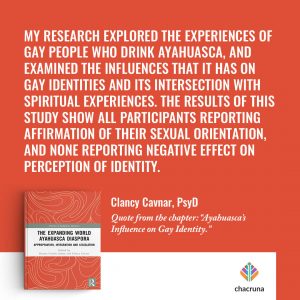 ayahuasca in a ceremonial context within the past three years, regarding their self-perceptions and integration of group beliefs. Participants drank either in shamanic or Santo Daime ceremonies or, in the case of one participant, with an Afro-Brazilian group that used ayahuasca. All participants reported affirmation of their sexual orientation, and no participants reported negative effects on perception of identity. Additional positive effects in other areas of their lives, which they attributed to ayahuasca sessions, contributed to the overall positive outcomes that were reported by this group as a result of their ayahuasca ingestion.
ayahuasca in a ceremonial context within the past three years, regarding their self-perceptions and integration of group beliefs. Participants drank either in shamanic or Santo Daime ceremonies or, in the case of one participant, with an Afro-Brazilian group that used ayahuasca. All participants reported affirmation of their sexual orientation, and no participants reported negative effects on perception of identity. Additional positive effects in other areas of their lives, which they attributed to ayahuasca sessions, contributed to the overall positive outcomes that were reported by this group as a result of their ayahuasca ingestion.
8 – “Men,” “Shaman,” and “Ayahuasca” as Overlapping Clichés in the Peruvian Vegetalismo
Ana Gretel Echazú Böschemeier & Carl Kevin Carew
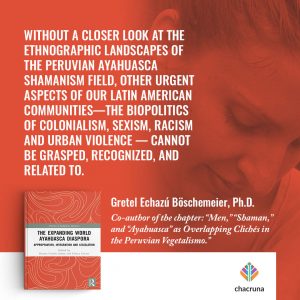 In this chapter we present the construction of the idea of a “Male-Shaman-Who-Heals-With-Ayahuasca” as an emergent myth in societies from the political North – a myth which asserts powerful meaning in a global world. This myth is related to power relationships between people and plants that are commodified and embedded in the context of capitalism and patriarchy. Guided by a reflexive empirical approach, we bring together four nodes of the myth (1. the
In this chapter we present the construction of the idea of a “Male-Shaman-Who-Heals-With-Ayahuasca” as an emergent myth in societies from the political North – a myth which asserts powerful meaning in a global world. This myth is related to power relationships between people and plants that are commodified and embedded in the context of capitalism and patriarchy. Guided by a reflexive empirical approach, we bring together four nodes of the myth (1. the 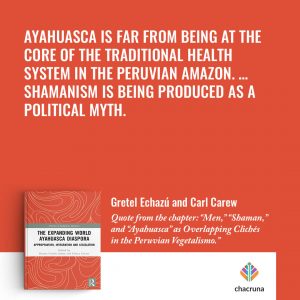 male, 2. the shaman, 3. the one who heals, and 4. the ayahuasca), in order to compare them systematically with key chosen aspects. Within the results of a historical approach and long-term ethnographic fieldwork in the Lowland Peruvian Amazon, we aim to provide tools for the deconstruction of this myth by examining social, cultural, and historical roots of Peruvian curanderismo. We consider four aspects: the local dynamics of gender, the diversity of the specialist practitioners, the complexity of ideas about healing and the centrality of plants in a local pharmacopoeia in which ayahuasca is but one plant among many.
male, 2. the shaman, 3. the one who heals, and 4. the ayahuasca), in order to compare them systematically with key chosen aspects. Within the results of a historical approach and long-term ethnographic fieldwork in the Lowland Peruvian Amazon, we aim to provide tools for the deconstruction of this myth by examining social, cultural, and historical roots of Peruvian curanderismo. We consider four aspects: the local dynamics of gender, the diversity of the specialist practitioners, the complexity of ideas about healing and the centrality of plants in a local pharmacopoeia in which ayahuasca is but one plant among many.
9 – What Ayahuasca Wants: Notes for the Study and Preservation of an Entangled Ayahuasca
Silvia Mesturini Cappo
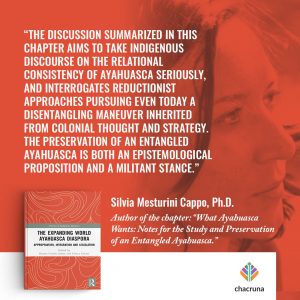 The recognition of Ayahuasca as a being, capable of agency and intention, taking action both as an healing and teaching spirit and as an ethical entity making a stand in the contemporary struggle for ecological survival and for indigenous culture valorisation is the central interrogation of this paper. What makes Ayahuasca an entity? Who is she an entity for? The importance of these questions is due to their centrality throughout multi-sited fieldwork conducted since 2004 among contemporary international shamanic networks linking various South American locations, namely the Peruvian Amazon, and European capitals such as Brussels, Paris and Rome. Field research has revealed that the comprehension, or
The recognition of Ayahuasca as a being, capable of agency and intention, taking action both as an healing and teaching spirit and as an ethical entity making a stand in the contemporary struggle for ecological survival and for indigenous culture valorisation is the central interrogation of this paper. What makes Ayahuasca an entity? Who is she an entity for? The importance of these questions is due to their centrality throughout multi-sited fieldwork conducted since 2004 among contemporary international shamanic networks linking various South American locations, namely the Peruvian Amazon, and European capitals such as Brussels, Paris and Rome. Field research has revealed that the comprehension, or 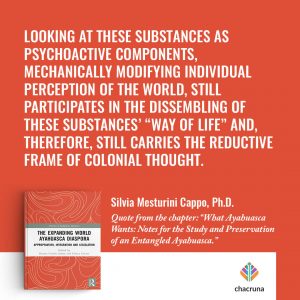 acceptance, of Ayahuasca as an entity is what differentiates the drug tourist and the long-term apprentice or practitioner. The more Ayahuasca becomes a “presence” the more the she moves from a space of “exceptional experience” to a space of regular, and yet extraordinary, “praxis”. But what does it mean, for a western secularized audience, to interact with her? What did it take for Ayahuasca to become a living entity to them? And what did it take them to become related to her? Attempting an answer to these questions will lead us to arguing what we’ve named “the hypothesis of an entangled Ayahuasca”. Comprehending Ayahuasca as entangled implies the acknowledgment of the numerous beings and diverse relations and interactions that call her into existence in a shared world and therefore are constitutive of her “being alive” and of her “wanting what she wants”.
acceptance, of Ayahuasca as an entity is what differentiates the drug tourist and the long-term apprentice or practitioner. The more Ayahuasca becomes a “presence” the more the she moves from a space of “exceptional experience” to a space of regular, and yet extraordinary, “praxis”. But what does it mean, for a western secularized audience, to interact with her? What did it take for Ayahuasca to become a living entity to them? And what did it take them to become related to her? Attempting an answer to these questions will lead us to arguing what we’ve named “the hypothesis of an entangled Ayahuasca”. Comprehending Ayahuasca as entangled implies the acknowledgment of the numerous beings and diverse relations and interactions that call her into existence in a shared world and therefore are constitutive of her “being alive” and of her “wanting what she wants”.
10 – La Dieta: Ayahuasca and the Western Reinvention of Indigenous Amazonian Food Shamanism
Alex K. Gearin & Beatriz Caiuby Labate
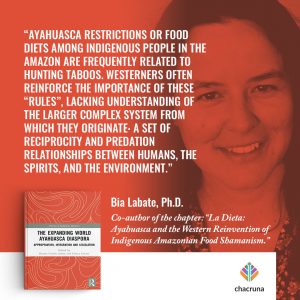 We undertake an unorthodox approach and investigate dietary and behavioural restrictions in the practice of Western ayahuasca drinking in comparison to indigenous Amazonian practices of dieting often believed to be the source of the “Western ayahuasca dieta”. Combining readings of Amazonian ethnography with the authors’ ethnographic research in neoshamanic contexts of ayahuasca drinking in Australia, the United States, and Peru, we consider how the practice of ayahuasca dieting has become detached from indigenous cosmologies and sanitized into a series of techniques that Westerners employ in the hope of attaining certain psychological
We undertake an unorthodox approach and investigate dietary and behavioural restrictions in the practice of Western ayahuasca drinking in comparison to indigenous Amazonian practices of dieting often believed to be the source of the “Western ayahuasca dieta”. Combining readings of Amazonian ethnography with the authors’ ethnographic research in neoshamanic contexts of ayahuasca drinking in Australia, the United States, and Peru, we consider how the practice of ayahuasca dieting has become detached from indigenous cosmologies and sanitized into a series of techniques that Westerners employ in the hope of attaining certain psychological and spiritual traits. We consider the dislocation of ayahuasca from indigenous cosmologies of reciprocity and predation—in which issues of human-environment relations are sanctioned and produced via shamanism—to a Western practice where “plant spirits” or “plant medicines” from an indigenous “tradition” meet the demands of the individual’s self-healing and personal development. This is explored by analysing key examples of indigenous food shamanism among indigenous Amazonian cultures in contrast to Western neoshamanic explanatory models of dieting, prescriptions to drink ayahuasca, and to the emic concept of “integration”. The comparison suggests how contradictions and limitations may occur when spiritual beliefs grounded in radically different social, economic and cosmological environments are appropriated and reinvented.
and spiritual traits. We consider the dislocation of ayahuasca from indigenous cosmologies of reciprocity and predation—in which issues of human-environment relations are sanctioned and produced via shamanism—to a Western practice where “plant spirits” or “plant medicines” from an indigenous “tradition” meet the demands of the individual’s self-healing and personal development. This is explored by analysing key examples of indigenous food shamanism among indigenous Amazonian cultures in contrast to Western neoshamanic explanatory models of dieting, prescriptions to drink ayahuasca, and to the emic concept of “integration”. The comparison suggests how contradictions and limitations may occur when spiritual beliefs grounded in radically different social, economic and cosmological environments are appropriated and reinvented.
11 – Power and Legitimacy in the Reconfiguration of the Yagecero Field in Colombia
Alhena Caicedo Fernández
 Recent years have been witness to growing global-level allegations of sexual assault in contexts of yage consumption. While an apparently exceptional phenomenon, it is a scarcely recognised and studied issue. Beyond its legal and ethical implications, my goal is to propose a more in-depth and contextual explanation of the framework of social relations in which the practice of ritual consumption takes place and, as such, shed light on that which is at stake in the reconfiguration of the yagecero field. This article presents a case study carried out in Colombia and based on the capture of a renowned Neoshaman accused of sexual
Recent years have been witness to growing global-level allegations of sexual assault in contexts of yage consumption. While an apparently exceptional phenomenon, it is a scarcely recognised and studied issue. Beyond its legal and ethical implications, my goal is to propose a more in-depth and contextual explanation of the framework of social relations in which the practice of ritual consumption takes place and, as such, shed light on that which is at stake in the reconfiguration of the yagecero field. This article presents a case study carried out in Colombia and based on the capture of a renowned Neoshaman accused of sexual  assault in 2015. It seeks to elucidate how, over a whole decade, this personality and his organisation provided evidence of the risks of a drift towards the sectarian as part of a Neoshamanic movement legitimised by the argument of indigenous authenticity. I propose an examination of the reconfiguration of the Colombian yagecero field promoted over the past thirty years by a growing process of urbanisation, elitisation and internationalisation, in a context whereby multiculturalism is exacerbated as a state policy. Such a transformation may be considered an interface between tradition and innovation based on which traditional yage consumption becomes available to new audiences, the ritual repertoire is amplified, new symbolic references are introduced and the mechanisms of the legitimacy and legality of its use are reformulated in the national and international context.
assault in 2015. It seeks to elucidate how, over a whole decade, this personality and his organisation provided evidence of the risks of a drift towards the sectarian as part of a Neoshamanic movement legitimised by the argument of indigenous authenticity. I propose an examination of the reconfiguration of the Colombian yagecero field promoted over the past thirty years by a growing process of urbanisation, elitisation and internationalisation, in a context whereby multiculturalism is exacerbated as a state policy. Such a transformation may be considered an interface between tradition and innovation based on which traditional yage consumption becomes available to new audiences, the ritual repertoire is amplified, new symbolic references are introduced and the mechanisms of the legitimacy and legality of its use are reformulated in the national and international context.
Author’s biographies
Beatriz Caiuby Labate has a Ph.D. in Social Anthropology from the State University of Campinas (UNICAMP), Brazil. Her main areas of interest are the study of psychoactive substances, drug policy, shamanism, ritual, and religion. She is Visiting Professor at the Center for Research and Post Graduate Studies in Social Anthropology (CIESAS), in Guadalajara, Mexico. She is also co-founder of the Interdisciplinary Group for Psychoactive Studies (NEIP), and editor of NEIP’s website (http://www.neip.info). Since 2016, she is Associate Editor at Chacruna (https://chacruna.net), a venue for publication of high-quality academic short texts on plant medicines. She is author, co-author, and co-editor of seventeen books, one special-edition journal, and several peer-reviewed articles. For more information, see: http://bialabate.net/
Glauber Loures de Assis has a Ph.D. in sociology from the Federal University of Minas Gerais (UFMG) in Belo Horizonte, Brazil. He is also Research Associate at the Nucleus for Interdisciplinary Studies of Psychoactives (NEIP) and co-founder of the Center of Sociology Studies Antônio Augusto Pereira Prates (CESAP). He has developed research on Santo Daime groups from Brazil and Europe, and has also studied the sociology of religion from a wider perspective. His main interests include the ayahuasca religions, the New Religious Movements (NRMs), the internationalization of the Brazilian religions, and drug use in contemporary society.
Juan Scuro has a PhD in social anthropology from the Federal University of Rio Grande do Sul (UFRGS) in Porto Alegre, Brazil. After completing undergraduate studies in anthropology at the Universidad de la República (UdelaR) in Montevideo, Uruguay, he earned his master’s degree at UFRGS in 2012, with a thesis on the process of transnationalization of Santo Daime to Uruguay. His doctoral dissertation, “Neoshamanis m in Latin America: A cartography from Uruguay,” addresses the processes of creation and transformation of neoshamanism in Uruguay through its origins in Brazil, Peru, and Mexico. It analyzes the interpellations that this tradition produces in the hegemonic narrative of the State-nation by identifying transformation processes of subjectivities, histories and memories. He is co-editor of Trama, journal of the Uruguayan Social Anthropology Association (AUAS) and a member of the Interdisciplinary Group for Psychoactive Studies (NEIP).
Jonathan Hobbs read Natural Sciences at Cambridge University where his dissertation looked at the medical history of psychedelics. He went on to study Science, Technology and Medicine in Society at University College London, Imperial College London and the Wellcome Trust. His research interests include the philosophy of psychedelic consciousness and the intersecting roles of science, governance, law and the public in the history of drugs control.
Gillian Watt obtained her first degree at the University of Cambridge, UK, (Clare College), in Social and Political Sciences with special interest in Latin America. She has had an interest in the ritual use of ayahausca since fieldwork with the Ashaninka people of the Ene region in Peru. A Masters at the Department of the Study of Religions, University College Cork, Ireland, resulted in the first study of the presence of the ayahuasca religion Santo Daime in the Republic of Ireland (see DISKUS www.religiousstudiesproject.com). Awarded a doctoral level research project through Academic Mobility for Inclusive Development in Latin America, (Erasmus Mundus) she worked on an investigation exploring the potentials of collaboration between alternative communities (e.g. ‘eco-villages’) and indigenous communities (Mbya Guarani) in Misiones north-east Argentina. At present she is continuing her Phd research at University College Cork, documenting various aspects of Santo Daime and related religious trends in the Republic of Ireland.
Ilana Seltzer Goldstein is Associate Professor in the Art History Department at the Federal University of São Paulo (UNIFESP). She is author and co-author of four books, one special-edition journal, and several peer-reviewed articles. Goldstein was co-founder of PROA – Revista de Antropologia e Arte [Journal of Anthropology and Art], dedicated to the interface between arts, cultural heritage, and the social sciences (http://www.revistaproa.com. br/05/). She was also co-curator of large-scale exhibitions, among which “Jorge, Amado e universal,” about the Brazilian best-selling writer Jorge Amado, which was held in São Paulo and Salvador in 2012; and “Dreamtime: the contemporary art of aboriginal Australians”, which was on show in São Paulo, Fortaleza, Rio de Janeiro, Brasília e Curitiba in 2016 and 2017. Her main areas of interest are anthropology of art, indigenous arts, cultural identity representation in art and literature and cultural public policies. For more information, see: http://buscatextual.cnpq.br/ buscatextual/visualizacv.do? id=K4794419P5.
Matthew Conrad is a PhD candidate in anthropology at La Trobe University, Melbourne, Australia, for which he is researching the relationship between health and well-being in Shipibo culture and ongoing expansion of ayahuasca tourism in the Pucallpa, Ucayali region of the Peruvian Amazon.
Clancy Cavnar has a doctorate in clinical psychology (PsyD) from John F. Kennedy University. She currently works at a dual-diagnosis residential drug treatment center in San Francisco and is a research associate of the Nucleus for Interdisciplinary Studies of Psychoactives (NEIP). She combines an eclectic array of interests and activities as clinical psychologist, artist, and researcher. She has a master of fine arts in painting from the San Francisco Art Institute and a master’s in counseling from San Francisco State University. She is author and co-author of articles in several peer-reviewed journals and co-editor, with Beatriz Caiuby Labate, of six books, among them, Ayahuasca Shamanism in the Amazon and Beyond (Oxford University Press, 2014). For more information see: http://www.neip.info/index.php/content/view/1438.html
Ana Gretel Echazú Böschemeier is an Argentinian feminist anthropologist. She graduated in Anthropology at the Universidad Nacional de Salta (Salta, Argentina), completed her Masters at the Universidade Federal de Rio Grande do Norte (RN, Brazil), and achieved her PhD at the Universidade de Brasília (DF, Brazil). She has been doing long term ethnographic fieldwork with indigenous storytellers in Northern Argentina, mestizo curanderos in the Peruvian Amazon; and women activists from rural Afro-descendant communities in Northeastern Brazil during the last fifteen years. She engages a compromised exercise of anthropology through her interest in the intersections between gender, race-ethnicity, body and health in Latin American contexts. Currently she is a Post-Doctoral researcher and teacher at the Department of Collective Health – Departamento de Saúde Coletiva – of the Universidade Federal de Rio Grande do Norte (Natal, RN, Brazil). She also researches and teaches sustainable and ethical approaches to medicinal plants through the CocoYuyo Social Project (Natal, RN, Brazil).
Carl Kevin Carew is a Guyanese ethno-botanist who studied Agriculture and Botany at the Botanical Garden School in New York. He worked at the National Parks Commission in Guyana and has put into effect projects related to the sustainable management of agriculture/aquaculture and waste management in the East Berbice Corentyne River in Guyana. He has also participated in projects in several permaculture spaces in Brazil and Venezuela. He investigated the local uses of medicinal plants in the Lowland Peruvian Amazon and how these uses connect to the architecture of mind from an experiential approach. He is currently building agricultural landscapes for medicinal and aromatic plants, distilling hydrosols and essential oils, and teaching about herbal medicines, sustainability, and the interrelationship between plants and culture at the CocoYuyo Social Project in Natal, RN, Brazil.
Silvia Mesturini Cappo has a BA degree in social sciences from the Université Libre de Bruxelles, Belgium, a master’s degree in social science of religion from the Ecole Pratique d’Hautes Etudes of Paris (EPHE-Sorbonne), and a PhD in anthropology from the Université Libre de Bruxelles, Belgium, obtained in 2010. Her thesis, “Espaces Chamaniques en Movement: Itinéraires Vécus et Géographies Multiples” (Shamanic Spaces on the Move: Life Itineraries and Multiple Geographies between Europe and South America) is based on multi-sited fieldwork including European (France, Belgium, Holland and Spain) and South American locations (Peru, Bolivia, Ecuador, Colombia, and Argentina) conducted between 2004 and 2010. Her research on ayahuasca rituals and their internationalization is part of a wider interest in shamanic practice at large and its recent developments. Her ethnography has a special focus on ritual interaction, cultural translation, the making of spirits, the interactive construction of knowledge and meaning as well as the possibility of interspecies relationships and shared ways of life.
Alex K. Gearin has a PhD in anthropology from the University of Queensland (UQ), Brisbane, Australia. His PhD dissertation involves an ethnographic study of ayahuasca use in Australia and focuses on sensory, medical, and ethical themes of ritual practice and social organisation. He is currently an assistant professor in the Department of Anthropology and Ethnology, Xiamen University, Fujian Province, China. He is co-editor, with Beatriz Labate and Clancy Cavnar, of The World Ayahuasca Diaspora: Reinvention and Controversies (Routledge 2017). He is the Founder of the Online ayahuasca learning hub Kahpi.net.
Alhena Caicedo Fernández is an Assistant Professor at the Department of Anthropology at Universidad de los Andes, Bogotá, Colombia. She completed her BA in Anthropology at Universidad Nacional de Colombia; her first MA in Social Anthropology at the École des Hautes Études en Sciences Sociales (EHESS) in France; her second MA in ethnographic and documentary film at Paris X – Nanterre; and, last but not least, her PhD in Social Anthropology at EHESS, France. She is a member of the Latin American think tank RaizAL. Her research has focused on the expansion of the yagecero field in Colombia and Latin America; the transformation of yage Neoshamanism, heritagisation processes, and the social uses of traditional indigenous medicine. Among her most recent publications is her book La alteridad radical que cura: neochamanismos yajeceros en Colombia [The Radical Otherness that Heals: Yage Neoshamanism in Colombia] (Universidad de los Andes, 2015)
Take a minute to browse our stock:
Did you enjoy reading this article?
Please support Chacruna's work by donating to us. We are an independent organization and we offer free education and advocacy for psychedelic plant medicines. We are a team of dedicated volunteers!
Can you help Chacruna advance cultural understanding around these substances?
Become a Chacruna Member
To make a direct donation click the button below:
Wednesday, June 9th, 2021 from 12-1:30pm PST
REGISTER FOR THIS EVENT HERE
There is growing enthusiasm in Jewish communities about possible ancient use and modern applications of plant medicine in Jewish spiritual development. Psychedelic Judaism introduce new potential modes of healing...










